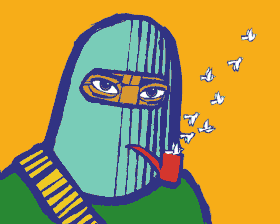mexico
No More Blood / No Más Sangre
The National Citizens’ Caravan for Peace with Justice and Dignity has traveled through Mexico and into Texas calling for the end to the so-called “war on drugs,” saying it’s only leading to more violence and to more drugs.
It’s a sober and visual affair with rallies, vigils, banners and posters — and this graphic in particular caught my eye. Designed by Alejandro Magallanes, it’s distinctive and modernist spare, camera friendly and vaguely echoes a civic pattern, but in its combination of text and symbol, also works in both English and Spanish.
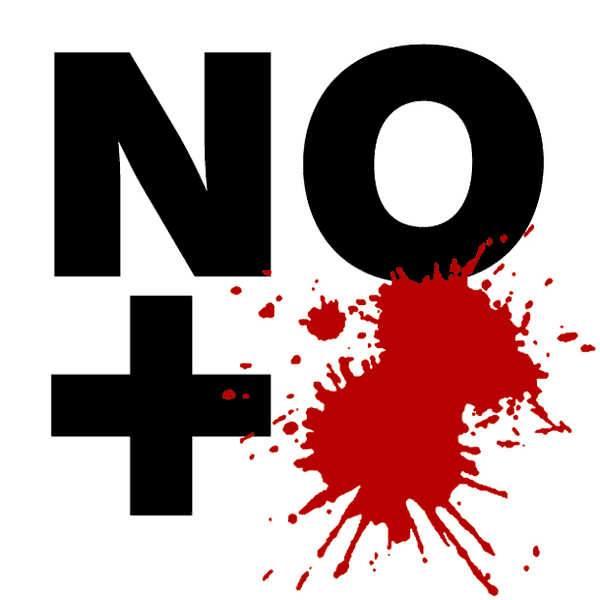
Mexican poet Javier Sicilia led the caravan following the brutal murder of his 24-year-old son by drug traffickers earlier this year. The caravan’s demands include an end to the Merida Initiative, in which the United States provides training and support for the Mexican army in its “war on drugs.” Related protests have occurred in over 40 Mexican cities, including an estimated 50,000-strong demonstration in Cuernavaca and 20,000 in Mexico City.
Méndez was a founder and leader of the Taller de Gráfica Popular.
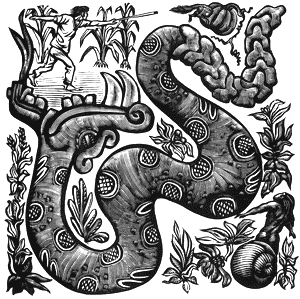
Migration and Displacement
Colectivo.Aliados 2.0 has a nice Flickr set of posters and photographs on migration and displacement. These are some of my favorites:
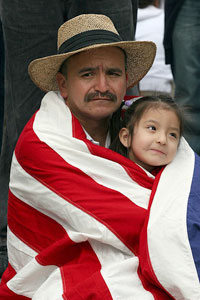
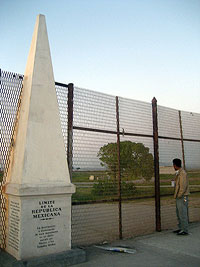
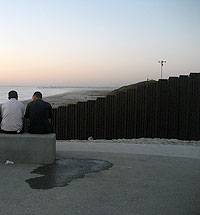
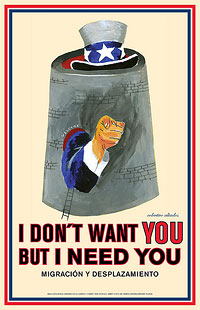
See previous online galleries of their poster work on war, the women of Juárez and domestic violence.
Paving the Clouds
UNESCO regonition seems to carry a heavy burden of opportunity.
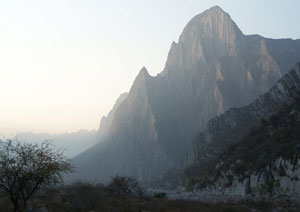 La Huasteca canyon, an ecological park in Cumbres de Monterrey National Park in north-eastern Mexico, may soon become part of a high-end residential development and golf course.
La Huasteca canyon, an ecological park in Cumbres de Monterrey National Park in north-eastern Mexico, may soon become part of a high-end residential development and golf course.
Last October, the municipality of Santa Catarina approved a 900 million dollar project to build more than 9,000 housing units and a 27-tee golf course in this place. Just a few days earlier it had been made part of a UNESCO biosphere network. Monterrey will also host the second Universal Forum of Cultures in 2007.
La Huasteca is a frequented family outing, camping and climbing site. One third of the drinking-water in Monterrey (pop. 3.7 million) comes from La Huasteca. There are over a thousand species in the area, seventy-three of which are endagered. See photos here.
The state and federal governments have pretty much washed their hands off the issue while local politicians, including a brother of the Governor, own part of the land.
Media coverage and activists have forced the new municipal authorities to claim they would freeze the project for at least three years, but they are now hinting they could give it the go-ahead this week.
Two activist websites are lahuasteca.org and voluntariosgreenpeace-mty.blogspot.com. Subcomandante Marcos shows his support to activists in this audio file.
See La Huasteca at Flickr, or read about it in Crain’s and La Jornada
Manifesto del Sindicato de Obreros Tecnicos, Pintores y Escultores, 1922
Manifesto issued by the Union of Technical Workers, Painters, and Sculptors, 1922
“Social, Political, and Aesthetic Declaration from the Union of Technical Workers, Painters, and Sculptors to the indigenous races humiliated through centuries; to the soldiers converted into hangmen by their chiefs; to the workers and peasants who are oppressed by the rich; and to the intellectuals who are not servile to the bourgeoisie:
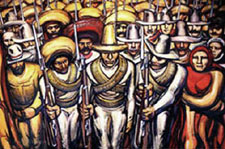 We are with those who seek to overthrow of an old and inhuman system within which you, worker of the soil, produce riches for the overseer and politician, while you starve. Within which you, worker in the city, move the wheels of industries, weave the cloth, and create with your hands the modern comforts enjoyed by the parasites and prostitutes, while your own body is numb and cold. Within which you, Indian soldier, heroically abandon your land and give your life in the eternal hope of liberating your race from the degradations and misery of centuries.
We are with those who seek to overthrow of an old and inhuman system within which you, worker of the soil, produce riches for the overseer and politician, while you starve. Within which you, worker in the city, move the wheels of industries, weave the cloth, and create with your hands the modern comforts enjoyed by the parasites and prostitutes, while your own body is numb and cold. Within which you, Indian soldier, heroically abandon your land and give your life in the eternal hope of liberating your race from the degradations and misery of centuries.
Not only the noble labor but even the smallest manifestations of the material and spiritual vitality of our race spring from our native midst. Its admirable, exceptional, and peculiar ability to create beauty — the art of the Mexican people — is the highest and greatest spiritual expression of the world-tradition which constitutes our most valued heritage. It is great because it surges from the people; it is collective, and our own aesthetic aim is to socialize artistic expression, to destroy bourgeois individualism.
We repudiate the so-called easel art and all such art which springs from ultra-intellectual circles, for it is essentially aristocratic.
We hail the monumental expression of art because such art is public property.
We proclaim that this being the moment of social transformation from a decrepit to a new order, the makers of beauty must invest their greatest efforts in the aim of materializing an art valuable to the people, and our supreme objective in art, which is today an expression for individual pleasure, is to create beauty for all, beauty that enlightens and stirs to struggle.”
David Siqueiros, et al., originally published as a broadside in Mexico City, 1922. Published again in El Machete, no. 7 (Barcelona, June 1924).
English translation from Laurence E. Schmeckebier Modern Mexican Art (Minneapolis: University of Minnesota, 1939), p. 31.
Zapata Vive!
Ten years ago, on January 1, 1994, a primarily indigenous rebel group, the Zapatista National Liberation Army (EZLN), declared war on the Mexican government. It was the same day NAFTA went into effect.
From a brief history of the Zapatistas:
“The systematic brutalization of indigenous communities and the tight control of the political machinery that allowed for no democratic openings constitute the conditions against which the Zapatistas organized. NAFTA is a key factor, since it sells off Mexican sovereignty and further erodes the autonomy of indigenous communities. The institution of NAFTA was preceded by the repeal of Article 27 of the Mexican constitution, which protected communal land holdings from privatization, part of the victory of land reforms of the Mexican Revolution of 1910. The Zapatistas have insisted that the further privatization of land means the death of indigenous cultures that are centrally determined by a collective relation to the land....
A key component of the Zapatistas’ uniqueness is that from the very beginning they have refused a vanguard role, calling out to different sectors of Mexican civil society to take up the struggle in their own ways.”
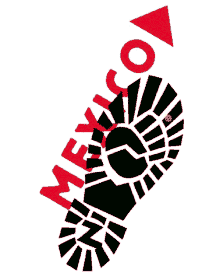 In February 2001, members of the EZLN began a march to Mexico City. The caravan included some of the oldest Zapatistas in the country who fought alongside of Emiliano Zapata at the beginning of the 20th century. Along the way they participated in the Third National Indigenous Congress with representatives of 40 of the 56 ethnic groups that live in Mexico. By the time the caravan reached Mexico City, it had grown to include several thousands of participants. [more]
In February 2001, members of the EZLN began a march to Mexico City. The caravan included some of the oldest Zapatistas in the country who fought alongside of Emiliano Zapata at the beginning of the 20th century. Along the way they participated in the Third National Indigenous Congress with representatives of 40 of the 56 ethnic groups that live in Mexico. By the time the caravan reached Mexico City, it had grown to include several thousands of participants. [more]
While representatives of the EZLN addressed the Mexican Congress, in the streets, two groups of Mexican designers, Fuera de Registro and La Corriente Electrica postered the city in solidarity.
The posters were also distributed by email with the following statement:
“The EZLN has arrived to Mexico City.
To welcome them, to support the indigenous people claims, to demand peace with justice and dignity, we have produced these images. Help us to distribute them. Use, share, print the images. We need every one’s help to demand the Mexican Government the following conditions to re-initiate the peace negotiatons with the EZLN.
- Constitutional recognition of the San Andres Agreements about Indigenous Rights and Culture.
- Freedom to all the zapatista prisoners.
- Withdrawal of the Mexican Army of the Chiapas Heights.
Mexico DF, March 2001.
Fuera de Registro, La Corriente Electrica.”
Rene Wanner has posted some images of the posters on his page, Zapata vive ! Mexican posters for peace in Chiapas.
“Fuera de Registro” is a pun which means “off register” in printing, as well as a person who can not vote because they are not registered.
Chiapas Indymedia has produced an audio documentary on ten years of Zapatismo.
The Women of Juárez Demand Justice
From Daoud Sarhandi in the Autumn 2003 issue of eye magazine:
‘Femicide’ posters
“El Paso, Texas, and Ciudad Juárez, a city of 1.5m people in the northern Mexican state of Chihuahua, are less than four km apart. Yet no two cities could be economically further apart. The shantytowns spread out around Juárez are home to a vast number of indigenous migrant workers who come there from the unemployment black spots of the agrarian south. Many hope to go further, ‘la otro lado’ [to the other side], but most get stuck in the slums, working all hours, earning barely enough to survive.
Women — many as young as fourteen — comprise 70 per cent of the Juárez workforce. They eke out a four-dollar-a-day living in the maquiladoras — sweatshop factories that have mushroomed along the border since Mexico signed up to the North American Free Trade Agreement in 1992. Yet in addition to exploitation and squalor, the women of Ciudad Juárez are oppressed by a murder rate that has attracted worldwide revulsion.
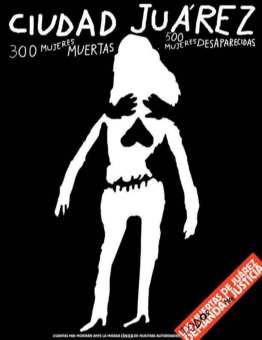 Statistics show that since 1993, at least 300 young women have been kidnapped, raped and killed — their bodies often defiled. Some 190 of these murders have occurred in the past six months; during the same period nearly 100 more have gone missing, presumed dead. The real toll may be higher, since many women do not have families living locally and their disappearances can go unnoticed and unreported. An open letter sent to the Interamerican Commission on Human Rights by angry Juárez residents puts the ‘disappeared’ figure at 450 in the past ten years.
Statistics show that since 1993, at least 300 young women have been kidnapped, raped and killed — their bodies often defiled. Some 190 of these murders have occurred in the past six months; during the same period nearly 100 more have gone missing, presumed dead. The real toll may be higher, since many women do not have families living locally and their disappearances can go unnoticed and unreported. An open letter sent to the Interamerican Commission on Human Rights by angry Juárez residents puts the ‘disappeared’ figure at 450 in the past ten years.
In the face of almost unbelievable official apathy and police incompetence, a group of graphic designers from Mexico City invited colleagues to express their concern and outrage by designing posters around the slogan ‘The Woman of Juárez Demand Justice’.
The first design activity — initially proposed by Rafael López Castro — was timed to coincide with last year’s International Day for the Elimination of Violence Against Women (25 November 2002), when protest marches against the Juárez killings took place in several towns. Nine designers produced a series of images for a support group working in Ciudad Juárez, which then distributed them to other groups dealing with domestic violence. Alejandro Magallanes and Leonel Sagahón, two designers at the centre of this project, point out that the designers gave away their images, encouraging the protest groups to apply their own text and messages.
Organised by Arnulfo Aquino and Xavier Bermúdez to mark International Women’s Day, the second event took place in March 2003. An exhibition of more than 60 large-format images by designers from all over the country was staged in a Mexico City metro station. Displays and exhibitions are often mounted in these big spaces: in a city of 20m-plus they are seen by huge numbers of people who may not often visit museums and galleries. Though Magallanes and Sagahón find several of the posters totally inappropriate, even offensive, no designs were censored from the exhibition.
López Castro notes an honest, if sometimes naíve, attempt to deal with a tough issue: the relationship between the sexuality of young, poor women, rape and murder. It has often been observed that the victims fit a series of patterns: apart from the fact that almost all come from the lower economic strata, the majority are in their teens, slim, attractive, and with long dark hair. Irresponsible local officials in Chihauhau have often blamed the girls themselves for the killings, citing the fact that they were out late and alone, or were wearing short skirts and make-up. Many designers saw these crimes — and the official reaction — as an attack on femininity itself.
López believes that the strength of this project rests in its role as a ‘collective shout’, intended to wake up the general population and the authorities. ‘It is important to see real problems,’ says Sagahón, ‘not just ‘design’ and ‘communication’ problems. We are designers, but we are also citizens, and we are also people.’
‘It was amazing,’ says Magallanes, ‘to see whole families standing in front of these posters and talking about this very difficult subject.’ One outcome of this publicity is that rather than continuing to rely on the hopelessly ad hoc investigative methods of the Chihuahua law enforcement agencies, the office of the Federal Prosecutor has now decided to investigate a number of the murders on behalf of the national government. Yet the murder phenomenon — or ‘femicide’ — shows no sign of abating. On the contrary, chillingly, it seems to be spreading to other northern Mexican towns with similar socio-economic conditions.”
The Center for the Study of Political Graphics has posted images of 60 posters online.
For more information on the violence in Juárez, see juarezwomen.com and womenontheborder.org.
Daoud Sarhandi is a co-author of Evil Doesn’t Live Here: Posters of the Bosian War.
United Farm Workers Logo
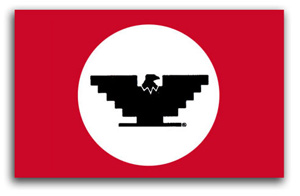
From Just Another Poster? Chicano Graphic Art in California:
In 1962, Cesar Chávez and his cousin Manuel conceived of the U.F.W. logo as a way to ‘get some color into the movement, to give people something they could identify with.’ they chose the Aztec eagle on the Mexican flag as the logo’s main symbol and created a stylized version of it that was easy to reproduce. The U.F.W. logo became a highly recognizable icon in the union’s boycott efforts, legislative, proposition campaigns, and a victorious symbol of its successful contract negotiations.
The symbol and flag were unveiled at the first mass meeting of the newly formed union.
From Aztlannet:
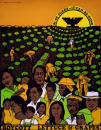 The evolution of Chicano poster art began in 1965 with the production of graphic images to support the organizing and boycotting efforts of the United Farm Workers. The U.F.W. logo — a black stylized eagle with wings shaped like an inverted Aztec pyramid — became a key symbol of the Chicano movement. It appeared prominently on all official U.F.W. graphics, and its inclusion on unrelated posters made by Chicano artists signaled support for the union. Posters also were utilized to promote other Chicano political causes, such as the 1968 Coors beer boycott in protest of the company’s discriminatory hiring practices.
The evolution of Chicano poster art began in 1965 with the production of graphic images to support the organizing and boycotting efforts of the United Farm Workers. The U.F.W. logo — a black stylized eagle with wings shaped like an inverted Aztec pyramid — became a key symbol of the Chicano movement. It appeared prominently on all official U.F.W. graphics, and its inclusion on unrelated posters made by Chicano artists signaled support for the union. Posters also were utilized to promote other Chicano political causes, such as the 1968 Coors beer boycott in protest of the company’s discriminatory hiring practices.
Gráficos y El Movimiento
From poster designer Mark Vallen:
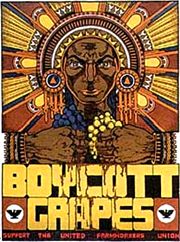 Just Another Poster? Chicano Graphic Arts in California, is the first exhibition and book that explores the Poster Art created by dozens of Chicano Artists in California from the late 1960’s to the present... Graphic art has played a key role in El Movimiento (the Chicano Civil Rights movement), and the poster has been used to educate, agitate, and organize Americans of Mexican descent...
Just Another Poster? Chicano Graphic Arts in California, is the first exhibition and book that explores the Poster Art created by dozens of Chicano Artists in California from the late 1960’s to the present... Graphic art has played a key role in El Movimiento (the Chicano Civil Rights movement), and the poster has been used to educate, agitate, and organize Americans of Mexican descent...
The posters frequently use Mexican icons reworked to express a unique Chicano perspective.
Chicano Poster Art became a means to help preserve and promote a culture largely ignored by the dominant Eurocentric society of the United States. Artists glorified Aztec Gods, Mexican Revolutionaries, the Virgin de Guadalupe, Immigrant Farm Workers, and the experiences of everyday Raza (people)...
Most of the work in the exhibit was produced in association with one of six major Chicano art centers and cooperatives: Royal Chicano Air Force (Sacramento), Galería de la Raza (San Francisco) and La Raza Silkscreen Center/La Raza Graphics (San Francisco), Self-Help Graphics and Art (Los Angeles) and the Mechicano Art Center (Los Angeles), and Centro Cultural de la Raza (San Diego). All but the Galería de La Raza were centers of poster production.
Boycott grapes poster by Xavier Viramontes, 1973, offset lithograph, printed by striking farm workers.
page 2 1


